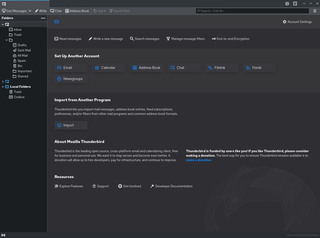
Electronic mail is a method of exchanging messages ("mail") between people using electronic devices. Email was thus conceived as the electronic (digital) version of, or counterpart to, mail, at a time when "mail" meant only physical mail. Email later became a ubiquitous communication medium, to the point that in current use, an e-mail address is often treated as a basic and necessary part of many processes in business, commerce, government, education, entertainment, and other spheres of daily life in most countries. Email is the medium, and each message sent therewith is called an email.
In computing, the Internet Message Access Protocol (IMAP) is an Internet standard protocol used by email clients to retrieve email messages from a mail server over a TCP/IP connection. IMAP is defined by RFC 9051.
Multipurpose Internet Mail Extensions (MIME) is an Internet standard that extends the format of email messages to support text in character sets other than ASCII, as well as attachments of audio, video, images, and application programs. Message bodies may consist of multiple parts, and header information may be specified in non-ASCII character sets. Email messages with MIME formatting are typically transmitted with standard protocols, such as the Simple Mail Transfer Protocol (SMTP), the Post Office Protocol (POP), and the Internet Message Access Protocol (IMAP).
Within the Internet email system, a message transfer agent (MTA), or mail transfer agent, or mail relay is software that transfers electronic mail messages from one computer to another using SMTP. The terms mail server, mail exchanger, and MX host are also used in some contexts.
In computing, the Post Office Protocol (POP) is an application-layer Internet standard protocol used by e-mail clients to retrieve e-mail from a mail server. POP version 3 (POP3) is the version in common use.
The Simple Mail Transfer Protocol (SMTP) is an internet standard communication protocol for electronic mail transmission. Mail servers and other message transfer agents use SMTP to send and receive mail messages. User-level email clients typically use SMTP only for sending messages to a mail server for relaying, and typically submit outgoing email to the mail server on port 587 or 465 per RFC 8314. For retrieving messages, IMAP is standard, but proprietary servers also often implement proprietary protocols, e.g., Exchange ActiveSync.

An email client, email reader or, more formally, message user agent (MUA) or mail user agent is a computer program used to access and manage a user's email.
Webmail is an email service that can be accessed using a standard web browser. It contrasts with email service accessible through a specialised email client software. Examples of webmail providers are 1&1 Ionos, AOL Mail, Gmail, GMX Mail, Mailfence, Outlook.com/Hotmail.com, Yahoo! Mail and IceWarp Mail Server. Additionally, many internet service providers provide webmail as part of their internet service package. Similarly, some web hosting providers also provide webmail as a part of their hosting package.
Various anti-spam techniques are used to prevent email spam.

Microsoft Mail was the name given to several early Microsoft e-mail products for local area networks, primarily two architectures: one for Macintosh networks, and one for PC architecture-based LANs. All were eventually replaced by the Exchange and Outlook product lines.
Mercury Mail Transport System is a standards-compliant mail server developed by David Harris, who also develops the Pegasus Mail client.
Push email is an email system that provides an always-on capability, in which new email is actively transferred (pushed) as it arrives by the mail delivery agent (MDA) to the mail user agent (MUA), also called the email client. Email clients include smartphones and, less strictly, IMAP personal computer mail applications.
cc:Mail is a discontinued store-and-forward LAN-based email system originally developed on Microsoft's MS-DOS platform by Concentric Systems, Inc. in the 1980s. The company, founded by Robert Plummer, Hubert Lipinski, and Michael Palmer, later changed its name to PCC Systems, Inc., and then to cc:Mail, Inc. At the height of its popularity, cc:Mail had about 14 million users, and won various awards for being the top email software package of the mid-1990s.
The following tables compare general and technical information for a number of notable webmail providers who offer a web interface in English.
Opportunistic TLS refers to extensions in plain text communication protocols, which offer a way to upgrade a plain text connection to an encrypted connection instead of using a separate port for encrypted communication. Several protocols use a command named "STARTTLS" for this purpose. It is a form of opportunistic encryption and is primarily intended as a countermeasure to passive monitoring.
SMTP proxies are specialized mail transfer agents (MTAs) that, similar to other types of proxy servers, pass SMTP sessions through to other MTAs without using the store-and-forward approach of a typical MTA. When an SMTP proxy receives a connection, it initiates another SMTP session to a destination MTA. Any errors or status information from the destination MTA will be passed back to the sending MTA through the proxy.
Backscatter is incorrectly automated bounce messages sent by mail servers, typically as a side effect of incoming spam.
SMTP Authentication, often abbreviated SMTP AUTH, is an extension of the Simple Mail Transfer Protocol (SMTP) whereby a client may log in using any authentication mechanism supported by the server. It is mainly used by submission servers, where authentication is mandatory.
A mailbox provider, mail service provider or, somewhat improperly, email service provider is a provider of email hosting. It implements email servers to send, receive, accept, and store email for other organizations or end users, on their behalf.
The JSON Meta Application Protocol (JMAP) is a set of related open Internet Standard protocols for handling email. JMAP is implemented using JSON APIs over HTTP and has been developed as an alternative to IMAP/SMTP and proprietary email APIs such as Gmail and Outlook. Additional protocols and data models being built on top of the core of JMAP for handling contacts and calendar synchronization are meant to be potential replacements for CardDAV and CalDAV, and other support is currently in the works.


